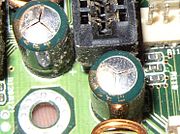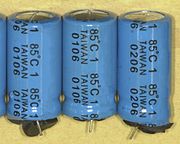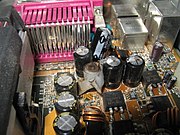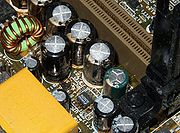
The capacitor plague was a problem related to a higher-than-expected failure rate of non-solid aluminium electrolytic capacitors between 1999 and 2007, especially those from some Taiwanese manufacturers, due to faulty electrolyte composition that caused corrosion accompanied by gas generation; this often resulted in rupturing of the case of the capacitor from the build-up of pressure.
High failure rates occurred in many well-known brands of electronics, and were particularly evident in motherboards, video cards, and power supplies of personal computers.
A 2003 article in The Independent claimed that the cause of the faulty capacitors was due to a mis-copied formula. In 2001, a scientist working in the Rubycon Corporation in Japan stole a mis-copied formula for capacitors' electrolytes. He then took the faulty formula to the Luminous Town Electric company in China, where he had previously been employed. In the same year, the scientist's staff left China, stealing again the mis-copied formula and moving to Taiwan, where they created their own company, producing capacitors and propagating even more of this faulty formula of capacitor electrolytes.
History
First announcements
The first flawed capacitors linked to Taiwanese raw material problems were reported by the specialist magazine Passive Component Industry in September 2002. Shortly thereafter, two mainstream electronics journals reported the discovery of widespread prematurely failing capacitors, from Taiwanese manufacturers, in motherboards.
These publications informed engineers and other technically interested specialists, but the issue did not receive widespread public exposure until Carey Holzman published his experiences about "leaking capacitors" in the overclocking performance community.
Public attention

The news from the Holzman publication spread quickly on the Internet and in newspapers, partly due to the spectacular images of the failures – bulging or burst capacitors, expelled sealing rubber and leaking electrolyte on countless circuit boards. Many PC users were affected, and caused an avalanche of reports and comments on thousands of blogs and other web communities.
The quick spread of the news also resulted in many misinformed users and blogs posting pictures of capacitors that had failed due to reasons other than faulty electrolyte.
Prevalence
Most of the affected capacitors were produced from 1999 to 2003 and failed between 2002 and 2005. Problems with capacitors produced with an incorrectly formulated electrolyte have affected equipment manufactured up to at least 2007.
Major vendors of motherboards such as Abit, IBM, Dell, Apple, HP, and Intel were affected by capacitors with faulty electrolytes.
In 2005, Dell spent some US$420 million replacing motherboards outright and on the logistics of determining whether a system was in need of replacement.
Many other equipment manufacturers unknowingly assembled and sold boards with faulty capacitors, and as a result the effect of the capacitor plague could be seen in all kinds of devices worldwide.
Because not all manufacturers had offered recalls or repairs, do it yourself repair instructions were written and published on the Internet.
Responsibility
In the November/December 2002 issue of Passive Component Industry, following its initial story about defective electrolyte, reported that some large Taiwanese manufacturers of electrolytic capacitors were denying responsibility for defective products.
While industrial customers confirmed the failures, they were not able to trace the source of the faulty components. The defective capacitors were marked with previously unknown brands such as "Tayeh", "Choyo", or "Chhsi". The marks were not easily linked to familiar companies or product brands.
The motherboard manufacturer ABIT Computer Corp. was the only affected manufacturer that publicly admitted to defective capacitors obtained from Taiwan capacitor makers being used in its products. However, the company would not reveal the name of the capacitor maker that supplied the faulty products.
Symptoms
Common characteristics
The non-solid aluminium electrolytic capacitors with improperly formulated electrolyte mostly belonged to the so-called "low equivalent series resistance (ESR)", "low impedance", or "high ripple current" e-cap series. The advantage of e-caps using an electrolyte composed of 70% water or more is, in particular, a low ESR, which allows a higher ripple current, and decreased production costs, water being the least costly material in a capacitor.
| Electrolyte | Manufacturer series, type |
Dimensions D × L (mm) |
Max. ESR at 100 kHz, 20 °C (mΩ) |
Max. ripple current at 85/105 °C (mA) |
|---|---|---|---|---|
| Non-solid organic electrolyte |
Vishay 036 RSP, 100 μF, 10 V |
5 × 11 | 1000 | 160 |
| Non-solid, ethylene-glycol, boric-acid (borax) electrolyte |
NCC SMQ, 100 μF, 10 V |
5 × 11 | 900 | 180 |
| Non-solid water-based electrolyte |
Rubycon ZL, 100 μF, 10 V |
5 × 11 | 300 | 250 |
Premature failure
All electrolytic capacitors with non-solid electrolyte age over time, due to evaporation of the electrolyte. The capacitance usually decreases and the ESR usually increases. The normal lifespan of a non-solid electrolytic capacitor of consumer quality, typically rated at 2000 h/85 °C and operating at 40 °C, is roughly 6 years. It can be more than 10 years for a 1000 h/105 °C capacitor operating at 40 °C. Electrolytic capacitors that operate at a lower temperature can have a considerably longer lifespan.
The capacitance should normally degrade to as low as 70% of the rated value, and the ESR increase to twice the rated value, over the normal life span of the component, before it should be considered as a "degradation failure". The life of an electrolytic capacitor with defective electrolyte can be as little as two years. The capacitor may fail prematurely after reaching approximately 30% to 50% of its expected lifetime.
Electrical symptoms
The electrical characteristics of a failed electrolytic capacitor with an open vent are the following:
- capacitance value decreases to below the rated value
- ESR increases to very high values.
Electrolytic capacitors with an open vent are in the process of drying out, regardless of whether they have good or bad electrolyte. They always show low capacitance values and very high ohmic ESR values. Dry e-caps are therefore electrically useless.
E-caps can fail without any visible symptoms. Since the electrical characteristics of electrolytic capacitors are the reason for their use, these parameters must be tested with instruments to definitively decide if the devices have failed. But even if the electrical parameters are out of their specifications, the assignment of failure to the electrolyte problem is not a certainty.
Non-solid aluminium electrolytic capacitors without visible symptoms, which have improperly formulated electrolyte, typically show two electrical symptoms:
- relatively high and fluctuating leakage current
- increased capacitance value, up to twice the rated value, which fluctuates after heating and cooling of the capacitor body
Visible symptoms

When examining a failed electronic device, the failed capacitors can easily be recognized by clearly visible symptoms that include the following:
- Bulging of the vent on top of the capacitor. (The "vent" is stamped into the top of the casing of a can-shaped capacitor, forming a seam that is meant to split to relieve pressure build-up inside, preventing an explosion.)
- Ruptured or cracked vent, often accompanied by visible crusty rust-like brown or red dried electrolyte deposits.
- Capacitor casing sitting crooked on the circuit board, caused by the bottom rubber plug being pushed out, sometimes with electrolyte having leaked onto the motherboard from the base of the capacitor, visible as dark-brown or black surface deposits on the PCB. The leaked electrolyte can be confused with thick elastic glue sometimes used to secure the capacitors against shock. A dark brown or black crust up the side of a capacitor is invariably glue, not electrolyte. The glue itself is harmless.
-
 Failed Chhsi capacitor with crusty electrolyte buildup on the top
Failed Chhsi capacitor with crusty electrolyte buildup on the top
-
 Failed capacitors next to CPU motherboard socket
Failed capacitors next to CPU motherboard socket
-
 Failed Tayeh capacitors which have vented subtly through their aluminium tops
Failed Tayeh capacitors which have vented subtly through their aluminium tops
-
 Failed electrolytic capacitors with swollen can tops and expelled rubber seals, dates of manufacture "0106" and "0206" (January and February 2006)
Failed electrolytic capacitors with swollen can tops and expelled rubber seals, dates of manufacture "0106" and "0206" (January and February 2006)
-
 Failed capacitor has exploded and exposed internal elements, and another has partially blown off its casing
Failed capacitor has exploded and exposed internal elements, and another has partially blown off its casing
-
 Failed Choyo capacitors (black color) which have leaked brownish electrolyte onto the motherboard
Failed Choyo capacitors (black color) which have leaked brownish electrolyte onto the motherboard
Investigation
Implications of industrial espionage
Industrial espionage was implicated in the capacitor plague, in connection with the theft of an electrolyte formula. A materials scientist working for Rubycon in Japan left the company, taking the secret water-based electrolyte formula for Rubycon's ZA and ZL series capacitors, and began working for a Chinese company. The scientist then developed a copy of this electrolyte. Then, some staff members who defected from the Chinese company copied an incomplete version of the formula and began to market it to many of the aluminium electrolytic manufacturers in Taiwan, undercutting the prices of the Japanese manufacturers. This incomplete electrolyte lacked important proprietary ingredients which were essential to the long-term stability of the capacitors and was unstable when packaged in a finished aluminium capacitor. This faulty electrolyte allowed the unimpeded formation of hydroxide and produced hydrogen gas.
There are no public court proceedings related to the alleged theft, as Rubycon's complete electrolyte formula remained secure. However, independent laboratory analysis of defective capacitors has shown that many of the premature failures appear to be associated with high water content and missing inhibitors in the electrolyte, as described below.
Incomplete electrolyte formula
Unimpeded formation of hydroxide (hydration) and associated hydrogen gas production, occurring during "capacitor plague" or "bad capacitors" incidents involving the failure of large numbers of aluminium electrolytic capacitors, has been demonstrated by two researchers at the Center for Advanced Life Cycle Engineering of the University of Maryland who analyzed the failed capacitors.
The two scientists initially determined, by ion chromatography and mass spectrometry, that there was hydrogen gas present in failed capacitors, leading to bulging of the capacitor's case or bursting of the vent. Thus it was proved that the oxidation takes place in accordance with the first step of aluminium oxide formation.
Because it has been customary in electrolytic capacitors to bind the excess hydrogen by using reducing or depolarizing compounds, such as aromatic nitrogen compounds or amines, to relieve the resulting pressure, the researchers then searched for compounds of this type. Although the analysis methods were very sensitive in detecting such pressure-relieving compounds, no traces of such agents were found within the failed capacitors.
In capacitors in which the internal pressure build-up was so great that the capacitor case was already bulging but the vent had not opened yet, the pH value of the electrolyte could be measured. The electrolyte of the faulty Taiwanese capacitors was alkaline, with a pH of between 7 and 8. Good comparable Japanese capacitors had an electrolyte that was acidic, with a pH of around 4. As it is known that aluminium can be dissolved by alkaline liquids, but not that which is mildly acidic, an energy-dispersive X-ray spectroscopy (EDX or EDS) fingerprint analysis of the electrolyte of the faulty capacitors was made, which detected dissolved aluminium in the electrolyte.
To protect the metallic aluminium against the aggressiveness of the water, some phosphate compounds, known as inhibitors or passivators, can be used to produce long-term stable capacitors with high-aqueous electrolytes. Phosphate compounds are mentioned in patents regarding electrolytic capacitors with aqueous electrolytic systems. Since phosphate ions were missing and the electrolyte was also alkaline in the investigated Taiwanese electrolytes, the capacitor evidently lacked any protection against water damage, and the formation of more-stable alumina oxides was inhibited. Therefore, only aluminium hydroxide was generated.
The results of chemical analysis were confirmed by measuring electrical capacitance and leakage current in a long-term test lasting 56 days. Due to the chemical corrosion, the oxide layer of these capacitors had been weakened, so after a short time the capacitance and the leakage current increased briefly, before dropping abruptly when gas pressure opened the vent. The report of Hillman and Helmold proved that the cause of the failed capacitors was a faulty electrolyte mixture used by the Taiwanese manufacturers, which lacked the necessary chemical ingredients to ensure the correct pH of the electrolyte over time, for long-term stability of the electrolytic capacitors. Their further conclusion, that the electrolyte with its alkaline pH value had the fatal flaw of a continual buildup of hydroxide without its being converted into the stable oxide, was verified on the surface of the anode foil both photographically and with an EDX-fingerprint analysis of the chemical components.
See also
References
- ^ D. M. Zogbi (September 2002). "Low-ESR Aluminium Electrolytic Failures Linked to Taiwanese Raw Material Problems" (PDF). Passive Component Industry. 4 (5). Paumanok Publications: 10, 12, 31. Archived from the original (PDF) on 3 March 2016. Retrieved 15 June 2018.
- ^ The Capacitor Plague, Posted on 26 November 2010 by PC Tools
- Arthur, Charles (31 May 2003). "Stolen formula for capacitors causing computers to burn out". Business News. The Independent. Archived from the original on 25 May 2015. Retrieved 16 January 2020.
- Sperling, Ed; Soderstrom, Thomas; Holzman, Carey (October 2002). "Got Juice?". EE Times. Archived from the original on 28 February 2014. Retrieved 11 February 2014.
- ^ Chiu, Yu-Tzu; Moore, Samuel K (February 2003). "Faults & Failures: Leaking capacitors muck up motherboards". IEEE Spectrum. 40 (2): 16–17. doi:10.1109/MSPEC.2003.1176509. ISSN 0018-9235. Archived from the original on 5 January 2018. Retrieved 22 August 2014.
- Carey Holzman, Overclockers, Capacitors: Not Just For Abit Owners, Motherboards with leaking capacitors, 10/9, 2002, Archived 18 October 2014 at the Wayback Machine
- Hales, Paul (5 November 2002). "Taiwanese component problems may cause mass recalls". The Inquirer. Archived from the original on 10 May 2011. Retrieved 20 March 2023.
- "Capacitor failures plague motherboard vendors, GEEK, 7 February 2003". Archived from the original on 13 January 2015. Retrieved 14 December 2014.
- W. BONOMO, G. HOOPER, D. RICHARDSON, D. ROBERTS, and TH. VAN DE STEEG, Vishay Intertechnology, Failure modes in capacitors, Archived 14 December 2014 at the Wayback Machine
- "Mainboardhersteller steht für Elko-Ausfall gerade", Heise (in German) (online ed.), DE, archived from the original on 25 December 2014, retrieved 14 December 2014.
- Michael Singer, CNET News, Bulging capacitors haunt Dell, 31 October 2005 Archived 14 December 2014 at the Wayback Machine
- "Michael Singer, CNET News, PCs plagued by bad capacitors". Archived from the original on 14 December 2014. Retrieved 14 December 2014.
- The guardian technology blog, How a stolen capacitor formula ended up costing Dell $300m Archived 3 March 2016 at the Wayback Machine
- Vance, Ashlee (28 June 2010). "Suit Over Faulty Computers Highlights Dell's Decline". The New York Times. Archived from the original on 28 January 2021. Retrieved 8 March 2012.
- Repair and bad capacitor information, Capacitor Lab, archived from the original on 12 April 2022, retrieved 26 April 2022.
- ^ Liotta, Bettyann (November 2002). "Taiwanese Cap Makers Deny Responsibility" (PDF). Passive Component Industry. 4 (6). Paumanok Publications: 6, 8–10. Archived from the original (PDF) on 20 November 2015. Retrieved 3 November 2015.
- "Capacitor plague, identifizierte Hersteller (~identified vendors)". Opencircuits.com. 10 January 2012. Archived from the original on 11 March 2015. Retrieved 3 September 2014.
- Uzawa, Shigeru; Komatsu, Akihiko; Ogawara, Tetsushi; Rubycon Corporation (2002). "Ultra Low Impedance Aluminium Electrolytic Capacitor with Water based Electrolyte". Journal of Reliability Engineering Association of Japan. 24 (4): 276–283. ISSN 0919-2697. Accession number 02A0509168.
- "A. Albertsen, Electrolytic Capacitor Lifetime Estimation" (PDF). Archived (PDF) from the original on 17 January 2015. Retrieved 4 September 2014.
- Sam G. Parler, Cornell Dubilier, Deriving Life Multipliers for Electrolytic Capacitors Archived 4 March 2016 at the Wayback Machine
- The Aluminium Electrolytic Condenser, H. 0. Siegmund, Bell System Technical Journal, v8, 1. January 1229, pp. 41–63
- A. Güntherschulze, H. Betz, Elektrolytkondensatoren, Verlag Herbert Cram, Berlin, 2. Auflage 1952
- ^ "Motherboard Capacitor Problem Blows Up". Silicon Chip. AU. 11 May 2003. Archived from the original on 14 June 2012. Retrieved 7 March 2012.
- Blown, Burst and Leaking Motherboard Capacitors - A Serious Problem, PCSTATS, 15 January 2005 Archived 16 August 2016 at the Wayback Machine
- Low-ESR Aluminium Electrolytic Failures Linked to Taiwanese Raw Material Problems (PDF), Molalla, archived from the original (PDF) on 26 April 2012
- ^ Hillman, Craig; Helmold, Norman (2004), Identification of Missing or Insufficient Electrolyte Constituents in Failed Aluminium Electrolytic Capacitors (PDF), DFR solutions, archived (PDF) from the original on 26 June 2011, retrieved 2 January 2009
- "Low-ESR Aluminum Electrolytic Failures Linked to Taiwanese Raw Material Problems". Archived from the original on 22 June 2017. Retrieved 16 March 2022.
- Chang, Jeng-Kuei, Liao, Chi-Min, Chen, Chih-Hsiung, Tsai, Wen-Ta, Effect of electrolyte composition on hydration resistance of anodized aluminium oxide Archived 24 September 2015 at the Wayback Machine
Further reading
- H. Kaesche, Die Korrosion der Metalle - Physikalisch-chemische Prinzipien und aktuelle Probleme, Springer-Verlag, Berlin, 2011, ISBN 978-3-642-18427-7
- C. Vargel, Corrosion of Aluminium, 1st Edition, 2 October 2004, Elsevier Science, Print Book ISBN 978-0-08-044495-6, eBook ISBN 978-0-08-047236-2
- W. J. Bernard, J. J. Randall Jr., The Reaction between Anodic Aluminium Oxide and Water, 1961 ECS - The Electrochemical Society
- Ch. Vargel, M. Jacques, M. P. Schmidt, Corrosion of Aluminium, 2004 Elsevier B.V., ISBN 978-0-08-044495-6
- Patnaik, P. (2002). Handbook of Inorganic Chemicals. McGraw-Hill. ISBN 0-07-049439-8.
- Wiberg, E. and Holleman, A. F. (2001). Inorganic Chemistry. Elsevier. ISBN 0-12-352651-5